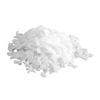potassium Hydroxide
Key Features
-
The use of Benefits and harms of potassium hydroxidein facial cleansers is somewhat harmful, but mixing it with oil can enhance oil hydrolysis and neutralize the reaction by attacking the acid after hydrolysis.
-
Alkali is essential for the preparation of cleaning products. Potassium hydroxide is used to make liquid soap. Soap and glycerol are formed after alkaline and oil reactions.
-
Potassium hydroxide is the principle of cleaning solid soap or liquid soap. This soap is effective, safe and versatile.
Product Description
Potassium Hydroxide is an odorless, white or slightly yellow, flakey or lumpy solid which is often in a water solution. It is used in making soap, as an electrolyte in alkaline batteries and in electroplating, lithography, and paint and varnish removers. Potassium hydroxide is used to control and establish the pH of cosmetic products. The pH of the skin is slightly acidic, known as the acidic mantle. It is maintained by the sebaceous glands, sweat glands, and natural flora of the skin. This protects the skin from external factors like microbes, irritants, and exposure to harmful rays. It helps in reducing premature aging and irritation of the skin. It is important to maintain the normal pH balance of the skin in order to prevent detrimental effects on the skin. Since too acidic pH can irritate the skin and harms the skin, while too basic pH can cause depletion of vital lipids from the skin. pH adjusters or buffers maintain this pH balance of the product and avoids skin’s pH to shift too far from the normal range. It is also used in the saponification of oils which is quite an important step in making bath soaps or washes. It is used in formulations of bath products, cleansing agents, make-up products, shaving products, and other personal care products. Regulation and use of potassium hydroxide Products containing rye (potassium hydroxide) are regulated according to strict instructions prepared by the Food and Drug Administration. Potassium can have very different properties depending on its concentration and composition. When mixed with chloride at higher temperatures, it is converted to potassium or a salt (KCl). This type of salt is sometimes used in the food and beverage industry as a substitute for salt made from sodium chloride. The structure of potassium hydroxide is formed when potassium combines with sodium hydroxide. Potassium hydroxide reacts violently by producing high heat acids. In humid weather, it spoils metals such as tin, lead, zinc and aluminum. This gas releases combustible and explosive hydrogen in the process. Chemists immerse the raw potassium metal in mineral oil during storage and take care of their skin and eyes when working with potassium hydroxide, because it is a strong irritating base. In case of contact with skin, eyes, inhalation and ingestion should be treated immediately. Because it causes severe poisoning. The Food and Drug Administration has approved potassium hydroxide as GRAS (commonly known as safe) as a direct food additive.

